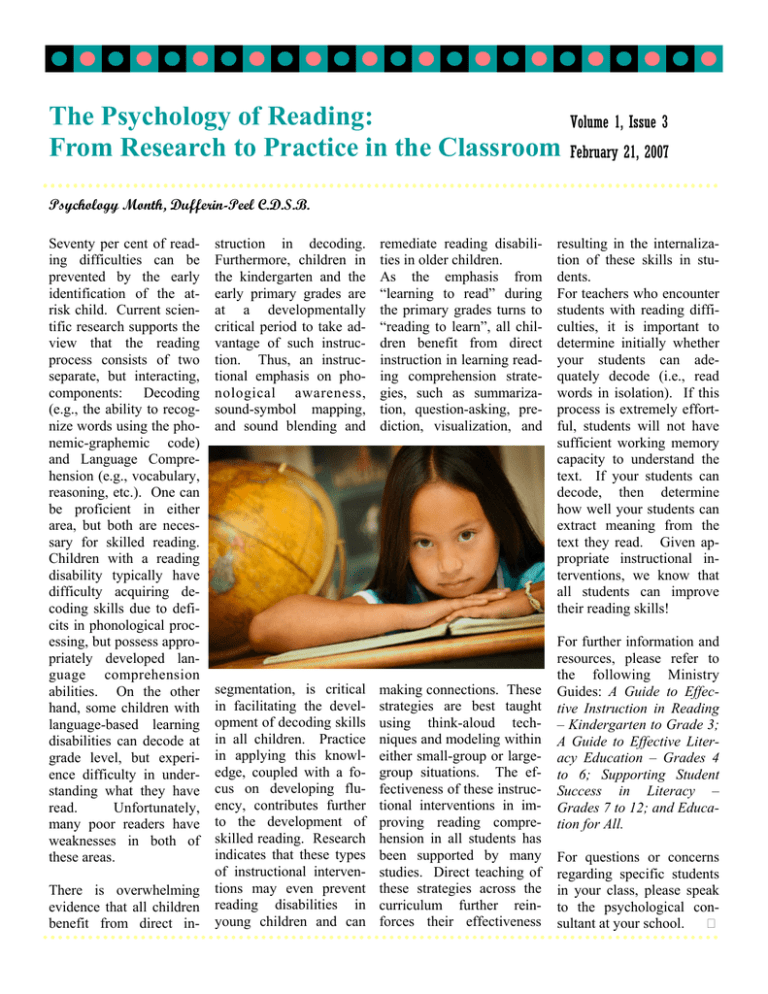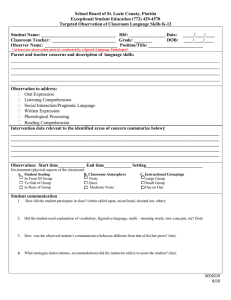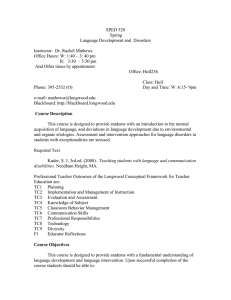The Psychology of Reading: From Research to Practice in the Classroom
advertisement

The Psychology of Reading: From Research to Practice in the Classroom Volume 1, Issue 3 February 21, 2007 Psychology Month, Dufferin-Peel C.D.S.B. Seventy per cent of reading difficulties can be prevented by the early identification of the atrisk child. Current scientific research supports the view that the reading process consists of two separate, but interacting, components: Decoding (e.g., the ability to recognize words using the phonemic-graphemic code) and Language Comprehension (e.g., vocabulary, reasoning, etc.). One can be proficient in either area, but both are necessary for skilled reading. Children with a reading disability typically have difficulty acquiring decoding skills due to deficits in phonological processing, but possess appropriately developed language comprehension abilities. On the other hand, some children with language-based learning disabilities can decode at grade level, but experience difficulty in understanding what they have read. Unfortunately, many poor readers have weaknesses in both of these areas. There is overwhelming evidence that all children benefit from direct in- struction in decoding. Furthermore, children in the kindergarten and the early primary grades are at a developmentally critical period to take advantage of such instruction. Thus, an instructional emphasis on phonological awareness, sound-symbol mapping, and sound blending and segmentation, is critical in facilitating the development of decoding skills in all children. Practice in applying this knowledge, coupled with a focus on developing fluency, contributes further to the development of skilled reading. Research indicates that these types of instructional interventions may even prevent reading disabilities in young children and can remediate reading disabilities in older children. As the emphasis from “learning to read” during the primary grades turns to “reading to learn”, all children benefit from direct instruction in learning reading comprehension strategies, such as summarization, question-asking, prediction, visualization, and making connections. These strategies are best taught using think-aloud techniques and modeling within either small-group or largegroup situations. The effectiveness of these instructional interventions in improving reading comprehension in all students has been supported by many studies. Direct teaching of these strategies across the curriculum further reinforces their effectiveness resulting in the internalization of these skills in students. For teachers who encounter students with reading difficulties, it is important to determine initially whether your students can adequately decode (i.e., read words in isolation). If this process is extremely effortful, students will not have sufficient working memory capacity to understand the text. If your students can decode, then determine how well your students can extract meaning from the text they read. Given appropriate instructional interventions, we know that all students can improve their reading skills! For further information and resources, please refer to the following Ministry Guides: A Guide to Effective Instruction in Reading – Kindergarten to Grade 3; A Guide to Effective Literacy Education – Grades 4 to 6; Supporting Student Success in Literacy – Grades 7 to 12; and Education for All. For questions or concerns regarding specific students in your class, please speak to the psychological consultant at your school.





